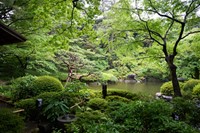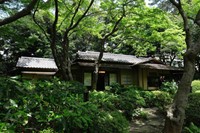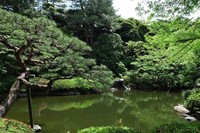Last weekend, Prada Mode took over the Tokyo Metropolitan Teien Art Museum and its surrounding gardens with art, architecture and music
It feels part of Prada’s remit that, when organising any event around the world, we go off the beaten track, to some place extraordinary and unexpected. A couple of prime examples: the Fondazione Prada, with its gold-leafed ‘Haunted House’ perched incongruously alongside Rem Koolhaas’s futurism in the bold redesign of a former Milanese distillery. Or how about Prada Rong Zhai, an early-20th century mansion in the centre of Shanghai whose style fuses French classicism and traditional Chinese elements, meticulously restored by Prada over the course of six years. Its interiors are now often interrupted by the high-profile contemporary art installations favoured by Miuccia Prada and Patrizio Bertelli (and by her Prada co-designer, Raf Simons, come to think of it) which cause an arresting friction. The first time I went there, a Lucio Fontana painting disrupted the walls of the former dining room as part of a project curated by the artist Goshka Macuga titled ‘What Was I?’ which is a question you ask a lot, when Prada brings you to these reimagined, reinvented spaces.
Last weekend, the brand staged the ninth iteration of their much-imitated travelling social club, Prada Mode, as a two-day event in the heart of Tokyo. I say much imitated because it seems every other brand is trying to piggy-back onto the fusion of fashion and culture that Prada initiated with these and more programmes. But, of course, the originator does it best. Perhaps because Prada plunges head-first into whatever locale they’re staging their latest Mode in – in this instance, impressively commandeering the Tokyo Metropolitan Teien Art Museum in the institution’s first-ever collaboration with a brand. It was the brainchild of Kazuyo Sejima, the director of the museum since last June and a long-term Prada collaborator. Back in 2018, for Prada’s Spring/Summer 2019 collection, Sejima-san – as she is known – was invited alongside other leading female architects to design an accessory from nylon. Her unfurling bag, squiggled with multiple bulbous detachable mini-purses, as playful as many of the buildings designed by SANAA, the practice she co-founded in 1995, like the higgledy-piggledy stacked forms of Manhattan’s New Museum.
At the centre of her Prada Mode was a building – but it wasn’t actually open. It’s the former residence of Prince Asaka Yasuhiko, an art deco jewel completed in 1933 with interiors by the French designer Henri Rapin and a whole lot of Lalique, reflecting the prince’s then newly-discovered passion for the style, observed first-hand with trips to Paris in the 1920s. A select few were afforded a tour, but it is currently closed to the public, who instead enjoy the expansive surrounding gardens.
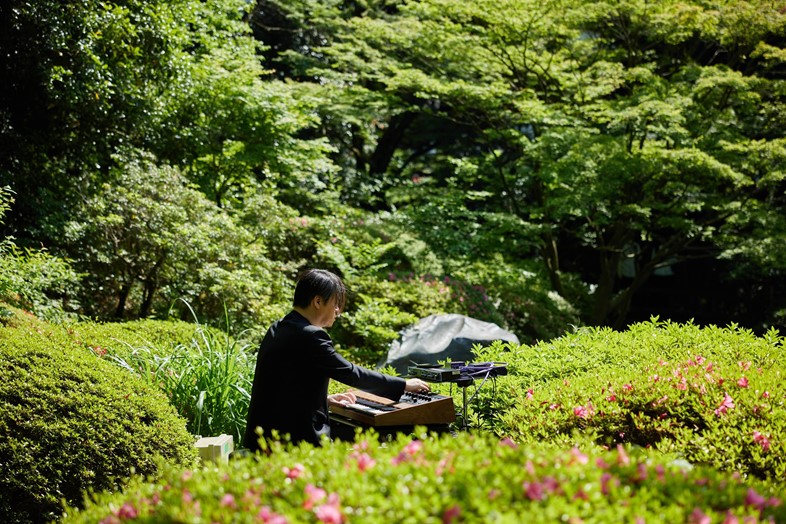
Sejima decided to link the two: “I started to think it would be nice to connect the building and the garden – to be able to use it all as one continuous space,” she says. Ryue Nishizawa designed a temporary pavilion – an arcing bow of wood, seemingly barely anchored to the grass of Teien’s European-style garden – which brought the museum outside and played host to a series of talks around art and architectural themes. The participants were jaw-dropping: the artist Hiroshi Sugimoto conversed with Sen Sooku, a direct descendant of a 16th-century tea master; Nishizawa spoke to fellow architect Junya Ishigami around the intersection of their respective works and landscapes; Sejima herself spoke to curator Yuko Hasegawa around the Inujima 'Art House Project’, which aims to use art, pavilions and creativity in general to bring life back to an island whose populous was in decline.
Almost echoing that notion – reinvigorating a space by having contemporary art and architecture living alongside its people – modern art installations punctuated the open spaces of the Teien gardens, as if a museum had exploded and scattered precious contents all around. It also invigorated the museum, for Sejima, whose programme, she says, is decided years in advance – like most institutions. “When I arrived so many things had already been decided that I thought I must open it in another way,” she says. The museum itself is, Sejima states, “a Japanese national treasure”. Prada Mode, conversely, gave her the opportunity to play, and to question what a museum could be in the 21st century. Rather than a repository for history, it becomes a stage for discussion, debate and exchange – and is framed by nature, as opposed to trying to exclude it. “I think museums can be imagined in a different way,” Sejima says.
And for her, a museum doesn’t have to mean a physical building. “I think, now, what is Earth, what is nature, what is artificial? It becomes more and more difficult to separate them,” Sejima says. “At first I wanted to put sculptures in the garden and blur the distinction between art and nature. If you look closely at the surface of trees or at ants running along the ground, these can also look like art. I wanted to encourage people to slow down, spend time and discover this environment.” One connective tissue between everything, for Sejima, was music – which bled between different, distinct areas of the garden, as if under one roof. “I’m not so good at music, but I wanted to connect the whole area and music does this very well,” she says. And performance pieces veered into music too – most notably with the composer Keiichiro Shibuya, who staged an Android opera in the gardens, epitomising Sejima’s aimed meeting of nature and the artificial.
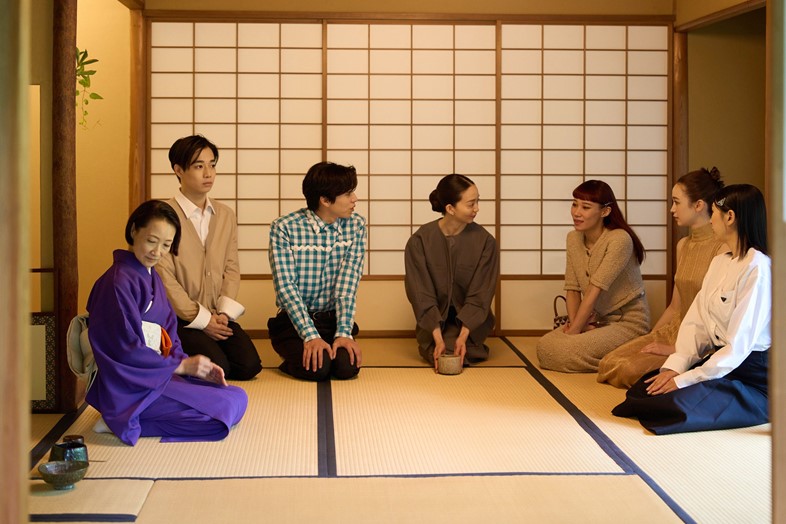
“This is a new type of connection and conversation in which architecture, garden, art and music become one,” says Sejima. “This event represents the opportunity for the museum to become a new public space.” And it also opened up Prada Mode – normally an invite-only event aimed at fashion and creative crowds – to a wider public audience for the first time. But probably not the last.
I wondered what Sejima’s aim was, in challenging both the notion of a museum – especially a ‘national treasure’ like Teien – and the newer concept of Prada Mode. “I would like to create an alternative kind of museum, one that becomes part of its context,” she says. “Prada Mode is interesting, right? Each time its character depends on the city, the local culture, the people who attend.”

